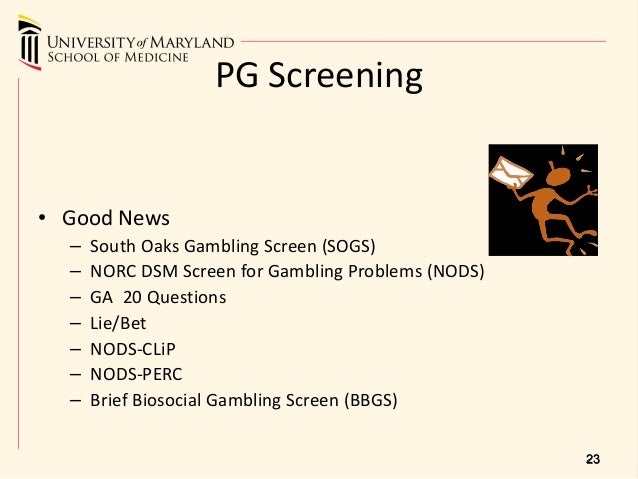Sogs South Oaks Gambling Screen
Despite widespread use, the South Oaks Gambling Screen (SOGS) has been criticized for excessive false positives as an indicator of pathological gambling (PG), and for items that misalign with PG criteria. The South Oaks Gambling Screen is a 20-item questionnaire based on DSM-III criteria for pathological gambling. It may be self-administered or administered by nonprofessional or professional interviewers. Currently, the South Oaks Gambling Screen (SOGS) is used as the enrollment tool into the publically funded disordered gambling treatment system through the DMHA. For screening, the DMHA encourages the use of a tool other than the SOGS. The approved tool is the Brief Biosocial Screen (BBGS). Adapting the South Oaks Gambling Screen for use in the Slovenian cultural environment Andreja Cvenkelj HIT d. D., Nova Gorica Abstract: South Oaks Gambling Screen (Lesieur in Blume, 1987) is the most frequently used for screening of pathological gambling. The main purpose of this study was to adapt the SOGS for ap.
Overview

The South Oaks Gambling Screen (SOGS) is a screen used to measure pathological gambling. This 16-item instrument asks questions related to many gambling behaviours. It also asks questions about how the individual feels about his or her own gambling habits. SOGS classifies individuals into one of three categories: non-problem gambler, problem gambler and probable pathological gambling. The SOGS can be used by individuals as a self-assessment tool, and mental health practitioners can also use this tool to screen their clients. A modified version of the SOGS for adolescents is also available and includes 12 items.
Key Points
It is important to remember that this tool is not a diagnoses of pathological gambling, however, studies have shown the SOGS to be a reliable and valid measure of gambling problems. The items relate to the clinical symptoms of gambling problem as presented by the DSM. Some authors have raised concerns with some of the questions asked in the SOGS. Specifically, questions regarding the amount of debt that a gambler accumulates and questions about having a line of credit are considered poor, as they do not directly measure gambling problems.
References

Stinchfield, R. (2002). Reliability, validity, and classification accuracy of the South Oaks Gambling Screen (SOGS). Addictive Behaviors, 27(1), 1-19.


Sogs South Oaks Gambling Screen Pdf
Orford, J., Sproston, K., & Erens, B. (2003). SOGS and DSM-IV in the British Gambling Prevalence Survey: Reliability and factor structure. International Gambling Studies, 3(1), 53-65.
Sogs South Oaks Gambling Screen Online
Young, M., & Stevens, M. (2008). SOGS and CGPI: Parallel comparison on a diverse population. Journal of Gambling Studies, 24(3), 337-356.